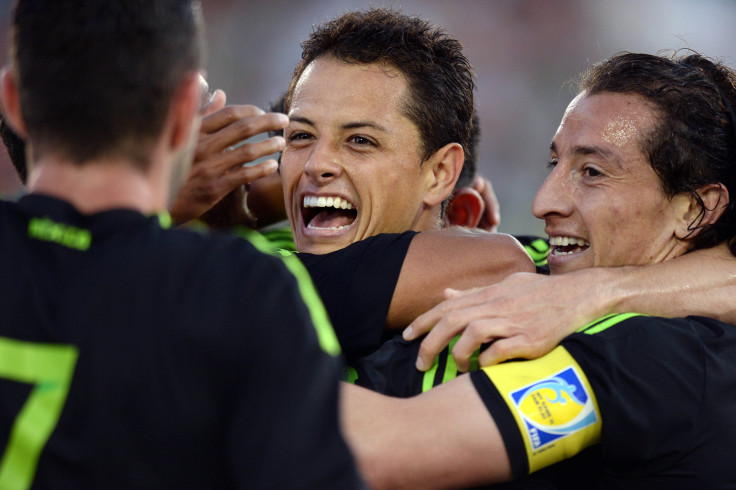Mexico vs. USA Soccer: Which Country Looks Stronger Ahead Of 2015 Gold Cup?

This summer’s Gold Cup promises to be one of the most compelling in some time, with both host nation the U.S. and traditional rivals Mexico having much to prove, while Costa Rica will be aiming to back up their run to the quarterfinal of the 2014 Gold Cup. The prize at stake is not just regional superiority but the chance to go to the increasingly prestigious Confederations Cup in 2017. After being crowned kings of Concacaf in 2013, a win for the U.S. team this time around will secure their place in Russia a year ahead of the next World Cup. Mexico must take the trophy to earn a playoff against the U.S. later this year.
Mexico have already made it clear how much importance the Gold Cup holds. With the country also competing in the Copa America in June, two distinct squads will be utilized this summer. The stronger one, though, will be heading to the U.S. It means it is unlikely that none of the players involved in Mexico’s recent friendly defeat to the U.S. in San Antonio will be seen in the starting lineup this July.
That result extended the Yanks' fine recent record over their once dominant rivals to the south. Indeed, El Tri have not beaten their foes since the Gold Cup final of 2011, when a convincing 4-2 defeat cost Bob Bradley his job and saw Jurgen Klinsmann brought in as the figurehead of U.S. soccer.
But Mexico now have far greater reason for optimism. The last Gold Cup came in the middle of a woeful year for the team under beleaguered manager José Manuel “Chepo” de la Torre, which saw them calamitously almost fail to qualify for the World Cup. Miguel Herrera was appointed to complete Mexico’s journey to Brazil and ever since the team has been playing with a real enthusiasm and purpose in his 5-3-2 formation.
Breeding further confidence, Mexico, in contrast to the past, now have a number of key players operating at a high level in Europe. Real Sociedad forward Carlos Vela, arguably Mexico’s most gifted player, is now an option again having returned from his self-imposed international exile. In his first appearance back, the former Arsenal man showed just what his country had been missing when scoring two goals in a 3-2 victory over the Netherlands in a friendly in Amsterdam last November.
At the Gold Cup he could well lineup alongside his partner that day, Javier “Chicharito” Hernández. And the golden boy of Mexican soccer is now looking in a much healthier state than just a few weeks ago, having scored four goals in as many appearances for Real Madrid. With midfielders Hector Herrera and Andres Guardado excelling at Porto and PSV Eindhoven, respectively, there is much to celebrate in forward areas, even if the defense remains much more of an uncertainty.
While Mexico now has players starring in Europe, the U.S. has gone the other way, with the country’s top players moving back to Major League Soccer. The spine of the team -- including Omar Gonzalez, Matt Besler, Michael Bradley, Jermaine Jones, Clint Dempsey and Jozy Altidore -- are all now based in the U.S.
However, the most notable aspect of the U.S. team’s fixtures since Brazil has been how little those key players have been on the same pitch together. Already looking forward to the next World Cup, Klinsmann has gone into full experimentation mode. Players from college, the U.S. second division NASL, Mexico and from all over Europe have been called up as the German coach expands the player pool in search of those who can contribute to the more proactive style he remains desperate to implement. Along the way a three-defender formation has also come and, at least for the time being, gone.
Largely, neither the results nor the performances have been good. Before an effectively U.S. “B” team beat an effectively Mexico “C” team on a rotten pitch earlier this month, there were just two wins, and four defeats in the nine internationals post-World Cup. Meanwhile, a theme developed of the U.S. shipping late goals.
The key question for the U.S. is to what degree Klinsmann scraps the experimentation at the Gold Cup and simply utilizes the players and formation that provide the best chance of delivering the trophy. History says it might be a bit of both.
For the first time in years there is also something of a question over the goalkeeping position. Long the strong spot of U.S. soccer player development, veteran Tim Howard is on a sabbatical from international play, while presumptive replacement Brad Guzan’s first-team place at Aston Villa could be in jeopardy after a horrendous error against Manchester City at the weekend.
While the depth in Mexico in terms of technical quality remains far higher than in the U.S., the strength of both team’s strongest lineups suggest it could be an incredibly closely fought, intriguing contest should the countries face off in the knockout stages at the Gold Cup.
Here’s how both countries could line up:
USA (4-4-2 diamond)
G: Guzan
D: Yedlin, Besler, Gonzalez, Johnson
M: Bedoya, Jones, Bradley, Diskerud
F: Dempsey, Altidore
Mexico (5-3-2)
G: Corona
D: Aguilar, Reyes, Márquez, Moreno, Layun
M: Herrera, Vazquez, Guardado
F: Hernández, Vela
© Copyright IBTimes 2024. All rights reserved.











